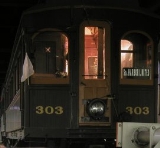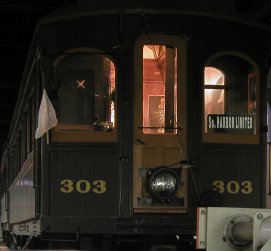
Cleveland railroad history
Encyclopedia

Early rail history
Cleveland railroading began in the 19th century when the New York Central and Nickel Plate Road (New York, Chicago, & St. Louis) built two major lines along Lake Erie that handled major traffic per day, and had major yards on them at this point.NKP's line bridged over the NYC's line in the western part of Cleveland, and the NYC line wyed in the mid-Cleveland area. One leg of the wye was an entity of NYC, the Cleveland, Cincinnati, Chicago and St. Louis (named Big Four).
CCC&StL
Cleveland, Cincinnati, Chicago and St. Louis Railway
The Cleveland, Cincinnati, Chicago and St. Louis Railway, also known as the Big Four Railroad and commonly abbreviated CCC&StL, was a railroad company in the Midwestern United States....
and the NYC came close to one another and paralleled each other for one mile (1.6 km) in west of Cleveland in Berea
Berea
Berea or Beroea may mean:In Lesotho:*Berea DistrictIn Romania:*Berea, a village in Ciumeşti Commune, Satu Mare CountyIn South Africa:*Berea, Durban*Berea, GautengIn the United States:*Berea, Kentucky*Berea, Baltimore, Maryland...
. After this point, the CCC&StL continued southwest to Cincinnati and the NYC continued west to Toledo.
The NKP line continued west to Bellevue where they had two major hump classification yards. Then it wyed. One branch headed south to Columbus and Kentucky, one continued west through Fostoria to Fort Wayne, IN.
After these three divisions built through Cleveland, a commuter line (somewhat like a trolley/street car) called the "Cleveland Union Terminal Railroad" (CUT) built around the downtown area of Cleveland. NYC had joint ownership of this railroad three years after its formation.
Another short line conglomerate system built around in a loop shape near downtown called the Newburgh & South Shore Railroad (N&SS). Back in the those times, what is now "Harvard" was called "Newburgh."
With now nearly 190 miles (305.8 km) of track in and around the downtown Cleveland area, the Erie Railroad
Erie Railroad
The Erie Railroad was a railroad that operated in New York State, New Jersey, Pennsylvania, Ohio, Indiana, and Illinois, originally connecting New York City with Lake Erie...
thought they ought to step in, which they did, purchasing 300 miles (482.8 km) of property, and built a 300 miles (482.8 km) line from Cleveland to Connellsville, PA (just south of Pittsburgh).
Wheeling & Lake Erie
Lake Erie
Lake Erie is the fourth largest lake of the five Great Lakes in North America, and the tenth largest globally. It is the southernmost, shallowest, and smallest by volume of the Great Lakes and therefore also has the shortest average water residence time. It is bounded on the north by the...
came into town about a year later with their line that ran south to Canton. At this time, Cleveland's industrial environment had seen a good upgrade with a lot of railroads serving the area.
Railroads built branch lines and industrial lines off of the main lines, and soon Cleveland had 960 miles (1,545 km) of track.
By this time, Pennsylvania had built their line from Pittsburgh into town, and Baltimore and Ohio built a line north from central Akron into town. A shortline switching company, the "River Terminal" railroad, was formed.
1950 to 1990
In the early 1950s, NKP started to fail at business, and in 1964, N&W bought the NKP. Now the NKP Lake line was in N&W's name, and N&W cancelled many of their stops in Cleveland, which forced other railroads to have to make runs instead of N&W.W&LE acquired one of the runs, and B&O acquired the other five. B&O had nearly 120 miles (193.1 km) of track in the Cleveland corporation limits at this time.
In 1967, NYC became PC, and then thought-to-be successful Penn Central canceled all of their stops in Cleveland, which put two factories in the hole. And one shut down completely.
One industry refused an offer from River Terminal and Newburgh & South Shore. They offered immediate business. The factory still turned them down, and eventually, the lights faded in that industry.
By this time, there were only a handful of industries left, when suddenly, a factory from "Whiskey Island" called B&O up (which at the time was filing for bankruptcy to Chessie system
Chessie System
Chessie System, Inc. was a holding company that owned the Chesapeake and Ohio Railway , the Baltimore and Ohio Railroad , the Western Maryland Railway , and several smaller carriers. It was incorporated in Virginia on February 26, 1973, and it acquired the C&O on June 15...
) to make the runs.
In 1971, B&O made their first run to Whiskey Island, and the Island seemed really successful, until Chessie took charge in 1972. Chessie cancelled their stop there in 1975 after acquiring Western Maryland
Western Maryland
Western Maryland is the portion of the U.S. state of Maryland that consists of Frederick, Washington, Allegany, and Garrett counties. The region is bounded by the Mason-Dixon line to the north, Preston County, West Virginia to the west, and the Potomac River to the south. There is dispute over the...
and obtaining more 'important' runs.
PC went bankrupt to Conrail a year later in 1976, and Conrail was a bright future for Cleveland. They re-opened many of the runs in Cleveland, and acquired the train to Whiskey Island.
Pretty soon, all you could find in Cleveland was Conrail. Conrail bought the CCC&StL, the NYC, the Pennsylvania, and the Erie.
Chessie was soon in competition with this and contacted many factories in Cleveland in search for trains to run, but it had seemed Conrail acquired all of them, the only Chessie run left, was the run to the dock facility near downtown, which was failing.
An unmentioned N&W line serving the dock was also in use, but failing severely. It wasn't long until the dock facilities went out, and N&W and Chessie had no runs left in Cleveland.
The Big Blue obtained N&SS and RT in 1979, then re-opened all the shortline companies as one single entity known as "Cleveland Works Railway Organization" (CWRO). The CWRO consisted of the "Cuyahoga Valley Industrial Railroad, the Newburgh & South Shore, the River Terminal and the Cleveland Union Terminal.
In 1980, Chessie was absorbed by CSX, and CSX opened one single line back to two tiny companies near the Cuyahoga River
Cuyahoga River
The Cuyahoga River is located in Northeast Ohio in the United States. Outside of Ohio, the river is most famous for being "the river that caught fire", helping to spur the environmental movement in the late 1960s...
in Cleveland. CSX started making some money here, so they continued those runs.
In 1982, the old N&W line was acquired in the merger by NS. NS also had some success at finding a couple needy businesses near downtown Cleveland
Downtown Cleveland
Downtown Cleveland is the central business district of the City of Cleveland and Northeast Ohio. Reinvestment in the area in the mid-1990s spurred a rebirth that continues to this day, with over $2 billion in residential and commercial developments slated for the area over the next few years...
. This run stayed open.
NS had spun off 16 miles (25.7 km) of track at this time, and a Class III bought it right up, without any engines or rolling stock
Railroad car
A railroad car or railway vehicle , also known as a bogie in Indian English, is a vehicle on a rail transport system that is used for the carrying of cargo or passengers. Cars can be coupled together into a train and hauled by one or more locomotives...
, known as the "Flats Industrial" railroad corporation.
FI arrived at an agreement and signed a contract with Conrail that they be under joint ownership with Conrail and the CWRO. FI was given one single SW1001 at the time, which is what they still have.
In late 1982, CWRO and Conrail got a call from local Cleveland welding and iron ore companies and one dock facility. They asked if they could have the CWRO companies serve their industry, which ran for 8 miles (12.9 km) along the Cuyahoga River.
They paid the CWRO $1.5 million up front. Of course, Conrail got a percentage of this money. The CWRO at this time was very successful, and bought 19 switcher locomotives which they keep based at the south end of the welding company.
Conrail soon paid the welding company for an outdoor barn-sized storage building. After the arrangements were made, Conrail gave this building to CWRO for a fee of course, and made it CWRO's own, personal repair shops.
In 1984, the Cleveland Union Terminal tracks were sold to the Regional Transit Authority (RTA) as a commuter business. The RTA still makes big bucks today in 2006.
1990 to present
In 1999, Conrail was split up on June 1 between NS and CSX. CSX got the former CCC&StL trackage, and the former B&O trackage. NS got the former NYC trackage, the former N&W trackage and the N&SS trackage which it bought from the CWRO in 2000 for $2.2 million.See also
- Railroad terminals of Cleveland, OhioRailroad terminals of Cleveland, OhioThe table below shows all railroad lines that have served downtown Cleveland, Ohio and what terminal they used. A red background indicates that the railroad owned a part or full share of the terminal....
- New York Central RailroadNew York Central RailroadThe New York Central Railroad , known simply as the New York Central in its publicity, was a railroad operating in the Northeastern United States...
- ConRailConsolidated Rail CorporationThe Consolidated Rail Corporation, commonly known as Conrail , was the primary Class I railroad in the Northeast U.S. between 1976 and 1999. The federal government created it to take over the potentially profitable lines of bankrupt carriers, including the Penn Central Transportation Company and...
- Cleveland Lakefront StationCleveland Lakefront StationCleveland Lakefront Station is Amtrak's station in Cleveland, Ohio. The station was built in 1976 to provide service to the Lake Shore Limited route, which was reinstated by Amtrak via Cleveland and Toledo in 1975...
- Akron, Bedford and Cleveland RailroadAkron, Bedford and Cleveland RailroadThe Akron, Bedford and Cleveland Railroad began service between Akron and Cleveland, Ohio on November 9, 1895. At the time of its completion, it was the longest electrified rail line in the world. For 50 cents riders could travel from Akron to Cleveland's Public Square in about 2½ hours...
General references
- Ohio Department of TransportationOhio Department of TransportationThe Ohio Department of Transportation is the organization of state government responsible for developing and maintaining all state and federal roadways in the state of Ohio with exception of the Ohio Turnpike. In addition to highways, the department also helps develop public transportation and...
- Norfolk Southern RailwayNorfolk Southern RailwayThe Norfolk Southern Railway is a Class I railroad in the United States, owned by the Norfolk Southern Corporation. With headquarters in Norfolk, Virginia, the company operates 21,500 route miles in 22 eastern states, the District of Columbia and the province of Ontario, Canada...
Short Lines - Ohio

